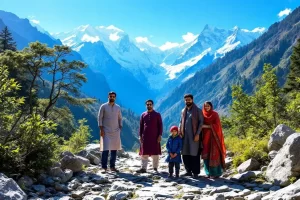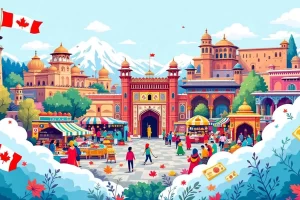The best time to visit various Indian regions from Canada considering seasons, festivals, and costs depends on the region, seasonal weather, major festivals, and travel expenses. The peak season, which extends from October to March, corresponds to the high tourist season in India, with favorable weather and increased crowds, which strongly influences travel planning.
Traveling between October and March is recommended for most Indian regions thanks to pleasant climate and vibrant festivities, with daytime temperatures ranging from 20°C to 25°C. These are the best months to visit India, as they offer ideal conditions to enjoy festivals and main attractions.
The best period to visit certain regions is from October to March, with daytime temperatures between 20°C and 25°C. Weather conditions vary depending on regions and seasons, which can influence the choice of destination and preferred activities.
Savvy travelers can save more by timing trips during off-peak monsoon or summer months, also known as the shoulder season.
Inshorts: The Best Time to Visit Various Indian Regions from Canada from October to March
October to March is ideal for most Indian destinations: the weather is cool and pleasant during this time of year, making it perfect for sightseeing and outdoor activities.
When is the best time to visit for festivals or weather? Festival travelers should consider Holi (March), diwali the festival of lights (in October and in November), Pongal (Jan), Hornbill Festival (Dec), as well as Ganesh Chaturthi (in August) and monsoon celebrations (in July). Holi, the festival of colors, is a popular celebration marking the arrival of spring.
Summer monsoon (April–September), especially in July and in August, mean fewer tourists and lower airfare, but also extreme heat and rainfall. At this time, some regions like Rajasthan remain viable to visit due to their drier climate, while others experience heavy rains.
Advance booking during peak (Oct–Feb) helps get better deals; at this time, you can enjoy major festivals and pleasant weather. Off-season offers cheaper flights and hotels, but the weather is less predictable.
Families, students, and professionals are advised to plan for flexibility, health, and festival interests, especially considering the weather is favorable in October, November, and March.
Why Timing Matters: Weather, Festivals & Costs — A Great Time to Visit India
Planning your trip to India from Canada requires balancing pleasant climate, festive atmosphere, and budget. Weather varies greatly by region and season, with cold peaks in the himalayas of the country in the north and tropical climate in the south. For example, the north is cooler and dry in winter, while the south can be hot and humid. Choosing the right time helps avoid extreme heat and monsoon, while enjoying festivals. Traveling to India in this time of year also requires careful organization due to distances and time zone differences. A visa for Canadians visiting India is mandatory, and Canadians can apply for a tourist e-visa. It is important to respect local customs and Indian dress codes.
Booking flights to India well in advance is key to securing the best prices, especially during the peak travel seasons. Multiple Canada to India flights are available, connecting major cities and offering convenient travel options. Additionally, India tour packages and holiday packages provide excellent ways to explore diverse regions with guided experiences and cost savings.
North India (New Delhi, Rajasthan, Himachal, Uttar Pradesh): The Best Time to Visit from October to March
Best Months: October–March. This is one of the best times to visit North India, especially the Golden Triangle (New Delhi, Agra, Jaipur). Cool days, crisp nights, and cultural festivals like diwali the festival of lights and Holi make travel pleasant and memorable. The best months to experience festivals and sightseeing are from October to March, as this period is one of the most favorable for tourism.
Festival Season: Diwali (Oct–Nov) lights up cities; Holi in March brings color and joy. The Pushkar Camel Fair is one of the most unique events, attracting thousands of visitors annually. These months are among the best times to explore local culture and participate in vibrant celebrations.
Costs: Winter is peak tourist time—advance booking secures the best deals. Shoulder months (March, October) are among the best times to visit, with fewer crowds and sometimes lower prices.
Avoid: April–June (very hot in plains, the heat can make travel uncomfortable), July–September (heavy monsoon rains). From December to March, vast areas of India are sunny and dry, making it an ideal period to explore.
South India (Kerala, Tamil Nadu, Karnataka, Andhra Pradesh): Time to Visit India from October to March
Best Months: October–March. Warm but not humid, with abundant sunshine; a great time for beach fun, backwaters, and cultural tours.
Festival Season: Pongal in Tamil Nadu (January), Mahabalipuram Dance Festival (Dec), Mysore Dasara (Oct), Chennai Music Festival (Dec).
Costs: Peak months see higher prices, so book ahead. April–September brings off-season discounts, especially during the start of the summer monsoon.
Travel Tip: The monsoon season (July–Sept) is magical in Kerala’s lush countryside but plan for rain protection. The best time to visit Kerala is from November to March, which is a great time to enjoy the region before the monsoon season begins.
East & North-East India (West Bengal, Assam, Sikkim, Meghalaya): The Best Time to Visit the Himalayas and Surrounding Regions
Best Months: October–April. Mild days, perfect for trekking in the himalayas and sightseeing, especially after monsoon when the scenery is vibrant. This period also corresponds to the best trekking season, ideal for exploring mountain trails. Popular destinations include hill stations like Darjeeling and Sikkim, as well as Ladakh, which is particularly accessible and pleasant between June and September. It is also a great time to observe wildlife, including the Bengal tiger in some national parks.
Festival Season: Durga Puja (Oct), Hornbill Festival in Nagaland (Dec), Wangala Festival in Meghalaya (Nov).
Costs: Budget-friendly packages abound for families and students—expect ₹15,000–₹25,000 per person for week-long trips in the North-East.
Spring Option: March-April is gorgeous, fewer crowds, clarity in the hills. The best time to visit the Indian himalayas is from November to February.
Western India (Goa, Maharashtra, Gujarat): Best Time to Visit India is November to February
Best Months: November–February. Not too hot or sticky; Goa beaches and Mumbai’s festivals are best enjoyed now. After the monsoon rains, which generally extend from June to September, the climate becomes more pleasant, especially in the west and central India, making this period ideal for travel.
Festival Season: Goa Carnival (Feb), Ganesh Chaturthi (Aug–Sept in Maharashtra). The best time to visit Mumbai is in January and February. During the monsoon rains from June to September, some activities may be limited due to heavy precipitation, but this period also coincides with local festivals.
Budget Tips: Late monsoon (Sept) sees hotel deals before festivals start. The best time to visit Goa is in January and February. Traveling during the monsoon rains from June to September can offer advantageous rates, but one must consider the impact of monsoon rains on travel and activities.
Money-Saving Tips for Canadian Travellers: A Great Time to Visit India Off-Peak
Book Early for Winter and Festivals: Airfares and hotels rise during October–March—reserve several weeks ahead. Booking Canada to India flights early ensures better availability and prices.
Travel Off-Peak for Lower Costs: April–September, especially monsoon months, offer cheaper rates.
Flexibility Pays: If you don’t mind rain or heat, traveling during off-peak can be a big saver for students and professionals. However, the months of April, May, and June are generally too hot for comfortable travel in India. Train and bus travel are economical options, but it is recommended to plan these journeys in advance due to high demand.
Key Takeaways for Families, Students & Professionals: Time to Visit India to Match Your Needs
Families: Pick winter (Oct–March) for sightseeing comfort and festival celebrations. Plan early for school holidays.
Students: Off-peak (April–Sept) means wallet-friendly travel; research local student discounts. Preventive malaria medication should be considered depending on the region visited. A hepatitis A vaccine is recommended for all travelers visiting India.
Professionals: Combine business with pleasure—plan around festivals or regional events for a richer experience.
All said, India in every time of year always has something special—just match your travel dreams with the right timing for the fullest experience! The vibrant culture of India is showcased through numerous festivals and events across the country. The festivals of Navratri and Dussehra take place in September or October and celebrate the victory of good over evil. It is essential to have adequate travel insurance to cover health and safety contingencies while visiting India.
Planning your visit to India from Canada means considering the diverse India seasons and holidays to make the most of your trip. India tourism thrives year-round, but understanding the best time to visit various parts of India can enhance your experience. Whether you are booking India flights, arranging a holiday package, or organizing group travel from Canada to India, timing your travel to coincide with favorable weather and cultural festivals is key to a memorable India travel adventure.






